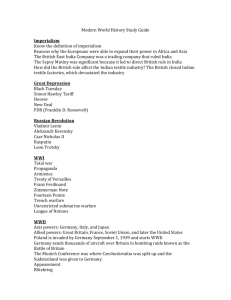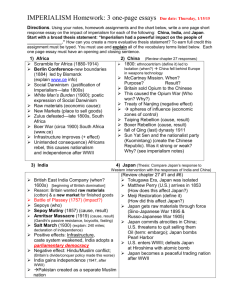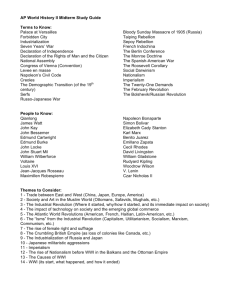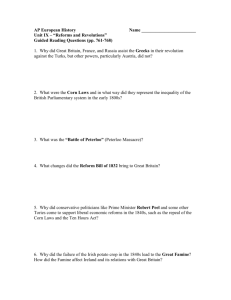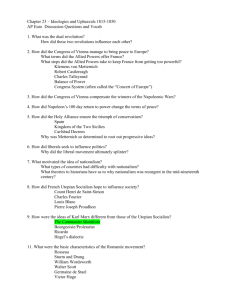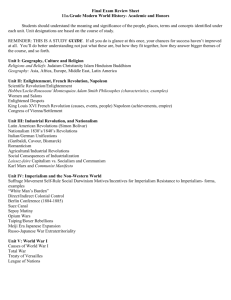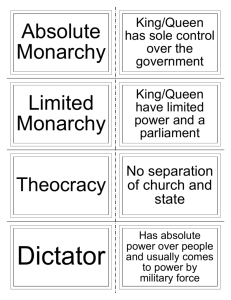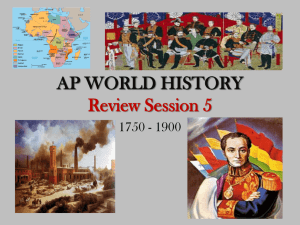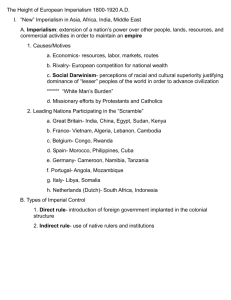TURNING POINTS Global II
advertisement
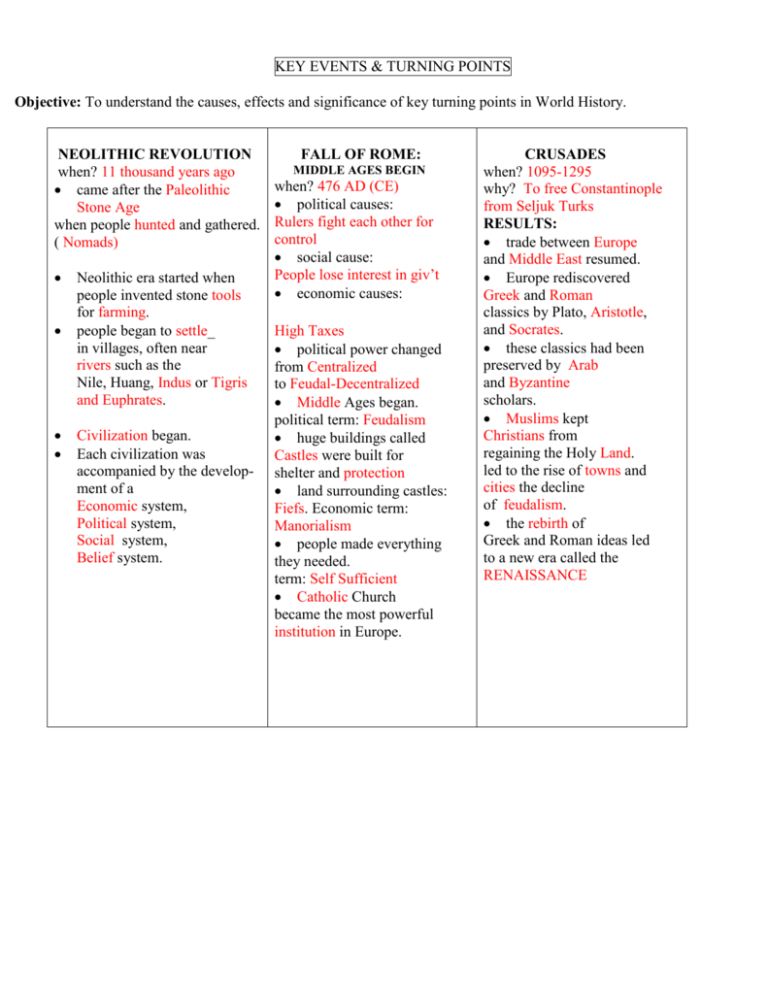
KEY EVENTS & TURNING POINTS Objective: To understand the causes, effects and significance of key turning points in World History. NEOLITHIC REVOLUTION when? 11 thousand years ago came after the Paleolithic Stone Age when people hunted and gathered. ( Nomads) Neolithic era started when people invented stone tools for farming. people began to settle_ in villages, often near rivers such as the Nile, Huang, Indus or Tigris and Euphrates. Civilization began. Each civilization was accompanied by the development of a Economic system, Political system, Social system, Belief system. FALL OF ROME: MIDDLE AGES BEGIN when? 476 AD (CE) political causes: Rulers fight each other for control social cause: People lose interest in giv’t economic causes: High Taxes political power changed from Centralized to Feudal-Decentralized Middle Ages began. political term: Feudalism huge buildings called Castles were built for shelter and protection land surrounding castles: Fiefs. Economic term: Manorialism people made everything they needed. term: Self Sufficient Catholic Church became the most powerful institution in Europe. CRUSADES when? 1095-1295 why? To free Constantinople from Seljuk Turks RESULTS: trade between Europe and Middle East resumed. Europe rediscovered Greek and Roman classics by Plato, Aristotle, and Socrates. these classics had been preserved by Arab and Byzantine scholars. Muslims kept Christians from regaining the Holy Land. led to the rise of towns and cities the decline of feudalism. the rebirth of Greek and Roman ideas led to a new era called the RENAISSANCE RENAISSANCE AGE OF EXPLORATION (VOYAGES OF COLUMBUS, when? 1300-1600s main cause: Crusades Renaissance means Reawakening (rebirth) Main concept: HUMANISM emphasized Individuality. artworks featuring humanism: Sistine Chapel by Michelangelo, Last Supper by Leonardo. Entrepreneurs, business owners who took risks, grew rich through trade A Market economy emerged so that people wouldn’t have to barter. Banks were started (where people kept money safe). rich Patrons of the arts, such as the Medicis, funded great art works. City States such as Venice, Florence, and Rome were like Athens in Ancient Greece. people began to question the authority of the Catholic Church leading to the Protestant Reformation as the power of the Catholic Church declined, the power of Monarchs increased. ultimately, this led to the rise of Absolute monarchs such as Louis XIV of France, Ferdinand of Spain, and Henry VIII of England. COLUMBIAN EXCHANGE) when? 1492 First permanent contact between Old World and New World Cause: Ottoman Turks blocked trade routes to the Middle East after conquering the Byzantine Empire Empire in 1453. led to the Age of Exploration and “ Triangular Slave trade” between Europe, Africa and the Americas Two countries from Iberian peninsula that conquered Latin America: Spain and Portugal main reason why Native Americans were conquered: Europeans had better technology and weapons Spanish term for conqueror: conquistador Cultural diffusion: products to the Old worldCocoa, potato, corn, beans, tobacco products to the New WorldSugar, bananas, pigs, diseases effect of European diseases: Killed many Native Americans terrible impact: Slave trade caused great human suffering and change of life in western Africa. led to Mercantilism, where ‘mother’ countries acquired raw materials and new markets. PROTESTANT REFORMATION when? 1517 started with Martin Luther from Germany who protested Sale of Indulgences. He nailed the 95 theses onto a church door. ended religious unity in Western Europe Luther translated the Bible into German (vernacular) new technology that spread the Bible’s message: Printing Press Henry VIII, king of England broke from the Catholic Church because Pope wouldn’t grant him a divorce. Catholic Church became weak therefore gov’t became stronger. This led to the rise of Absolute Monarchs such as Louis XIV. TURNING POINTS Global II French Revolution when? 1789 political cause-three estates: 1) Clergy – 1st Estate 2) Nobility- 2nd Estate 3) Peasants/Bourgeoisie- lacked political power Industrial Revolution when? 1750 where? England why England? 1)Natural Resources (coal and Iron) 2)Irregular Coastlines 3) Supportive Gov’t = $ economic cause: positive results: France, led by Louis XIV, Many more goods made since was deeply in debt caused by costly they could be produced by wars Machine. Steam powered iron ships could travel farther and more quickly. social cause: Enlightened thinkers Many inventions were created challenged the absolute along with many factories authority. People revolted and that fostered economic growth. stormed the Bastille in order Examples: release the political prisoners and Textile factories/power loom get weapons Ship building Railroads Telephone/telegraph major events: 1) tennis Court Oath 2) King Louis XVI and his wife, negative results: Marie Antoinette were beheaded Working conditions by Committee of Public Safety Low wages 3) But eventually M. Robespierre Long Hours was also beheaded Unsafe conditions How? guillotine Child labor 4) Napoleon gained control and expanded France’s influence. Better wages were also made. Positive? Negative? main results: 1) middle class ( Bourgeoisie ) Karl Marx hated gained political power. Capitalism. He wrote 2) French Revolution inspired the Communist Manifesto struggles for independence in Haiti which called for a over throw (San Domingo ) of industrial capitalism and in Bolivia and Columbia workers. Famous quote: ( New Granada). “Workers of the World Unite”! 3) expanded voting rights to all males, whether they owned property or not. Nationalism when? 1800s where/leader: Italy-Mazzini, Cavour, Garibaldi Germany- Otto von Bismark Turkey- Kemal Ataturk India- Gandhi Israel- Theodore Herzl Kenya- Jomo Kenyatta causes: Latin American revolutions were inspired by revolutions in France and the United States Italy was tired of being colonized, so nationalism became a popular cause.(against the French) Germany 1800s- disunity among the states-wanted to be free of French Rule results: Gangs of nations known as alliances were formed. Nations wanted more control to show off their wealth Power hungry leaders relied on force to achieve their goals. Along with imperialism, militarism, alliances, and nationalism were the MAIN causes of WWI and WWII which began in 1914 and 1939. Imperialism India: Became a British colony after the Sepoy Mutiny in 1857. England took raw materials such as salt and sold cotton products back to India. Human rights were violated. ( Human Rights Violations ) Tactics/events: Passive resistance and civil disobedience-Gandhi Salt March which proclaimed Indian Independence Boycott of British clothing. arrested for treason. General strike which shut down the country. Fasting to protest violence against the British and also to end Muslim-Hindu conflicts. Results: Gained Independence in 1947, but Pakistan was created as a homeland for the Muslims. Africa: same motives ( Independence) Kipling’s “ White man’s Burden” described British attitudes of Imperialism, Scramble for Africa lasted from 1880 to 1914. Africans began to resist oppression. Independence movements (i.e. Kenya ), were successful after WWII. CHINA: England gained power after Opium War (1839 ). Spheres of Influence were created. Negative response: Taiping Rebellion ( 1850-1864 ) led to fall of last dynasty and creation of a weak central government. JAPANESE EXCEPTION: US and great Britain did not colonize Japan. Instead, Japan became an imperialist nation. Won wars against Russia and China. Gained land in Manchuria and Korea. Turning point: Meiji Restoration after Matthew Perry landed in 1853. World War I when?1914-1918 World War II when? 1939-1945 MAIN causes M iliterism A lliances I mperialism N atioalism MAIN causes again, this shows how history repeats itself ! Employed new weapons of the Industrial rev including tanks, bombs, gas style : trench warfare. casualties:8.5 million Winners: US, Britain, and France Peace Plan: Versailles Treaty written by Woodrow Wilson called for a _________________ league of Nations to prevent future wars. But U.S. didn’t join and the League of Nations was weak Biggest loser, Germany, had to pay reparations which caused inflations and devastated the German economy Revenge created a backlash of German nationalism which led to the rise of Hitler, an evil dictator who murdered millions of men, women, and children. Hitler’s rise to power was unchecked due to Neville chamberlain , a British Prime Minister, who followed a policy of appeasement ( backing down to aggression). Allies: Britain, France, Soviet Union, USA Axis: Germany, Japan, Italy Some major events: Japan’s vicious takeover of Manchuria and Nanjing in China. Hitler’s invasion of Poland. Bombing of Pearl Harbor a naval base in Hawaii. D-day, landing of Allied forces in Europe. Costly battles on islands in the Pacific Ocean. Atom bombs dropped on Hiroshima, Nagasaki Results: Allies win!!!!!! VE day: May 1945 VJ day: Aug 1945 U. S. occupies Japan. Power struggle between US and Russia leads to the Cold War, an ideological battle which pitted American Democracy and capitalism against the Soviet Union’s Totalitarianism dictatorship and communism. Cold War conflicts in Vietnam and Korea were fought to stop the spread of communism The outcome was seen as a triumph of good over Evil It forced Great Britain, which had been weakened by WWII, to reevaluate its policy of imperialism. Soon Britain gave up colonial claims in Africa and India. China, under Mao underwent its communist Revolution after WWII. Its effects are still felt today. (i.e. Human Rights issue)

